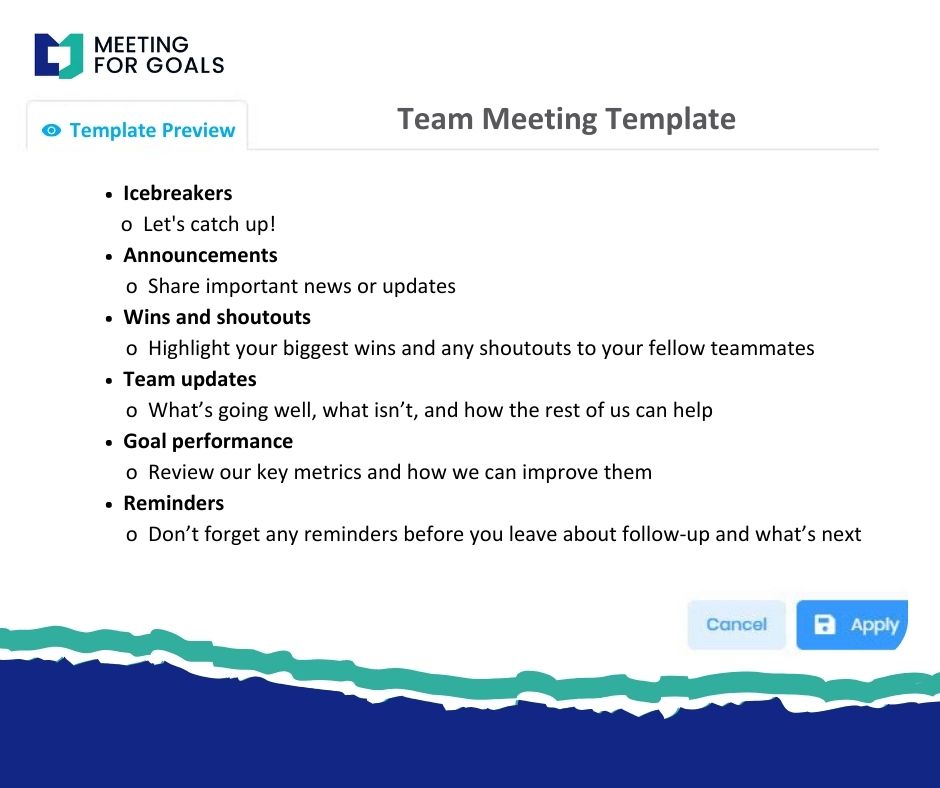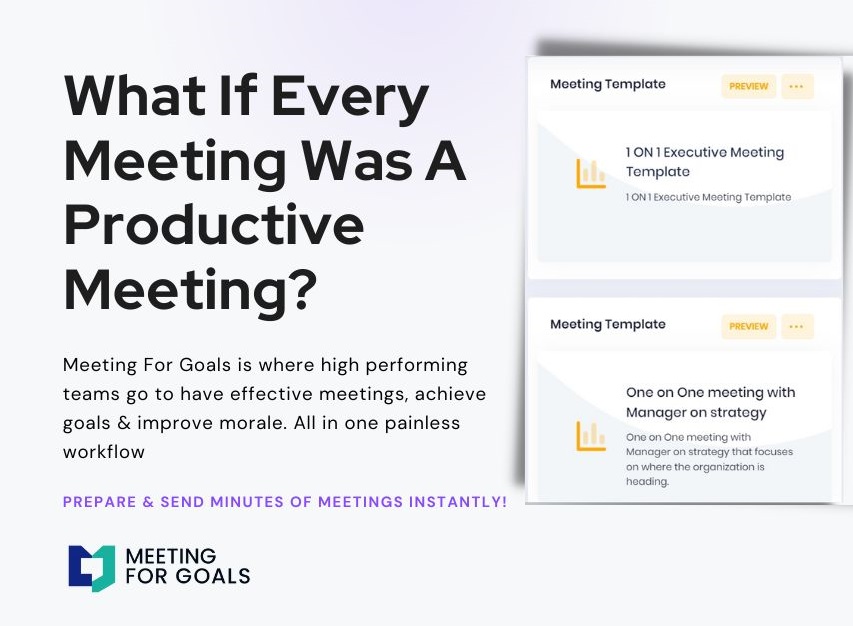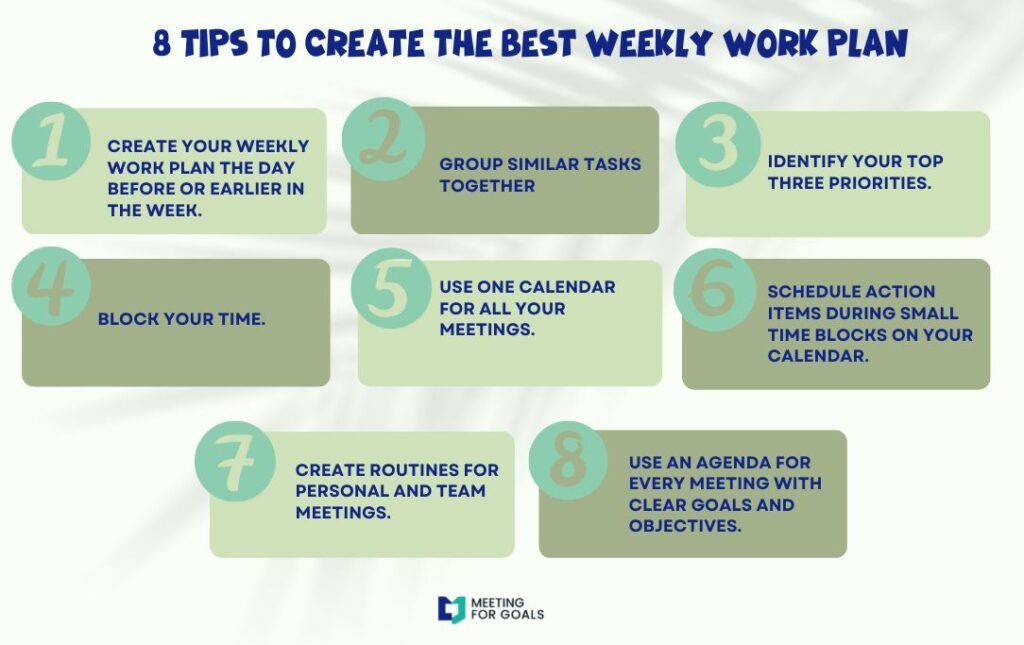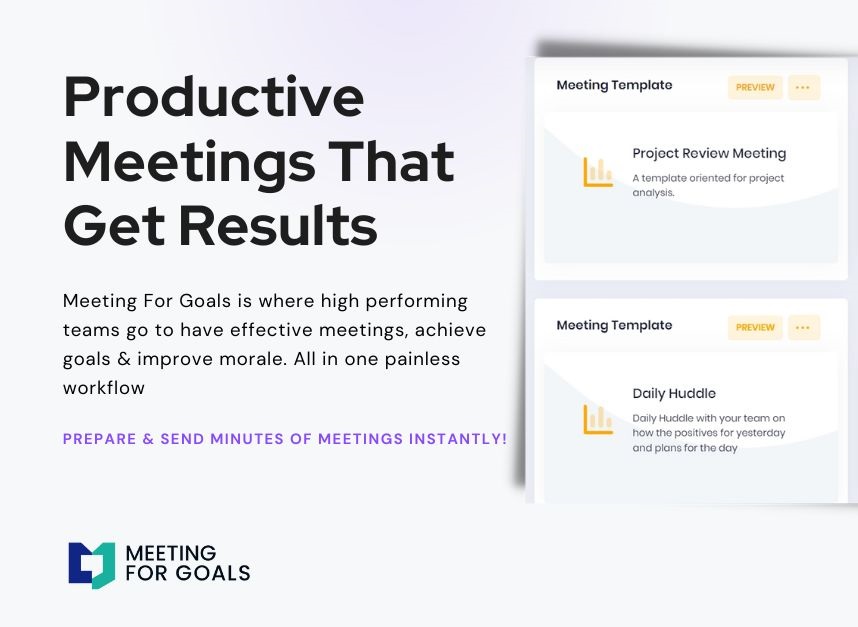Sales Meeting Agenda Template: Boost Productivity and Drive Results
Excerpt:
Effective sales meetings are the backbone of a high-performing sales team. Yet, too often, meetings become unfocused, unproductive, and a drain on valuable time. At Meeting For Goals, we believe every meeting should drive your team closer to achieving your company’s objectives — and it all starts with a structured agenda. In this guide, we’ll walk you through a comprehensive Sales Meeting Agenda Template that ensures every meeting is goal-oriented, time-efficient, and impactful. Whether you’re a VP of Sales, Director of Business Development, or a C-suite executive, this resource will help you lead meetings that align with your company’s mission and accelerate your team’s success.
If you’re looking for more ways to improve your meetings, check out our collection of free meeting templates here or sign up for a free account at Meeting For Goals to streamline your meeting process!
2 Minute Video
Watch a 2-minute demo of our meeting management software in action.
Introduction
Sales meetings are crucial touchpoints. They can either propel a team forward or hold them back. Without structure, meetings can quickly devolve into aimless discussions. This wastes time and dampens morale. That’s why having an effective sales meeting agenda template is essential.
At Meeting For Goals, we specialize in helping high-performing teams have more effective meetings that align with broader company goals. Our meeting management software is designed to make every meeting shorter, more focused, and more productive.
A well-crafted agenda provides clarity. It sets expectations and keeps everyone aligned. It prevents the common pitfalls of meetings: going off-topic, running overtime, or leaving participants wondering what the next steps are. Instead, it promotes a culture of preparation, responsibility, and continuous improvement.
In this post, we’ll show you a detailed Sales Meeting Agenda Template Outline you can adapt to your team’s needs. Each section is based on best practices used by top-performing organizations. These practices help keep their sales teams sharp, motivated, and aligned with strategic goals. Let’s dive in!
Adding an Agenda
How to add an agenda instantly on Meeting For Goals.
Objectives of the Sales Meeting
Before you even send out a meeting invite, it’s critical to define what you want to achieve. Clear objectives are the foundation of a productive sales meeting.
Typical objectives for a sales meeting include:
- Reviewing sales targets and performance metrics
- Identifying obstacles and challenges
- Brainstorming new strategies to boost sales
- Reinforcing alignment with broader company goals
- Celebrating wins and recognizing top performers
Setting clear objectives ensures that everyone knows why they are attending and what they are expected to contribute. It promotes a sense of accountability and responsibility, essential traits for any successful sales team.
For example, if your objective is to review quarterly sales performance, the meeting should focus tightly on that topic. If the goal is to brainstorm new lead generation strategies, the agenda should allocate ample time for creative discussion.
Moreover, aligning meeting objectives with broader company goals ensures that your team’s efforts are strategic. For instance, if expanding into a new market segment is a company priority, your sales meetings should reflect that focus by discussing relevant tactics and metrics.
At Meeting For Goals, we emphasize the importance of goal alignment in every meeting. Our software helps you set clear objectives and track progress over time. This improves accountability and ensures meetings drive success.
Remember: a meeting without clear objectives is like a ship without a rudder. Define your goals upfront, communicate them clearly, and watch your meetings become significantly more impactful.
Agenda Items Overview
Once your objectives are set, the next step is to structure your meeting with a clear set of agenda items. A well-organized agenda keeps discussions focused, participants engaged, and meetings on time.
Here’s a typical structure for a sales meeting agenda:
-
Review of Previous Meeting’s Action Items
Start by revisiting the action items assigned during the last meeting. This fosters accountability and ensures that nothing falls through the cracks. -
Current Sales Figures and Performance Metrics
Share up-to-date sales data, including KPIs, revenue numbers, and pipeline statistics. Use visual aids like graphs and dashboards to make this segment more engaging. -
Discussion of Challenges and Obstacles
Create a safe space for team members to discuss what’s blocking their success. Identifying challenges early enables the team to collaborate on solutions. -
Brainstorming New Sales Strategies or Initiatives
Encourage creative thinking by dedicating time to brainstorming. Whether it’s new outreach methods, updated sales scripts, or innovative marketing tactics, fresh ideas are the lifeblood of a dynamic sales team.
Each agenda item should be time-boxed to maintain focus and momentum. For instance, allocate:
- 10 minutes to review action items
- 15 minutes for performance metrics
- 20 minutes for challenges
- 15 minutes for brainstorming
At Meeting For Goals, we advocate for brevity and focus in every agenda. Our platform allows you to create templates that standardize these best practices. This ensures that your meetings are consistently productive and goal-driven.
Need more ideas for structuring your meetings? Explore our free meeting templates to get inspired!
Allocating Roles and Responsibilities
One often-overlooked aspect of effective meetings is the assignment of roles. When everyone knows their responsibilities, meetings run more smoothly and outcomes improve dramatically.
Key roles to assign in a sales meeting include:
-
Facilitator
Guides the meeting, keeps discussions on track, and ensures that the agenda is followed. -
Timekeeper
Monitors the time allotted for each agenda item and keeps the meeting moving at a steady pace. -
Note-taker
Records key points, decisions made, and action items assigned during the meeting. -
Presenters
Individuals responsible for presenting specific data, updates, or proposals.
Assigning roles ahead of time ensures participants come prepared and understand their contributions. It also distributes responsibility. This makes meetings more collaborative rather than top-down.
At Meeting For Goals, our tool makes it easy to allocate roles within your meeting invites and agendas. This clarity drives engagement and ensures that every participant actively contributes.
Additionally, rotating roles among team members can help develop leadership skills across your sales organization. For example, having different team members facilitate meetings can build confidence and improve communication skills.
Remember: meetings are a team sport. When everyone has a role to play, engagement increases, accountability deepens, and outcomes improve.
Effective Meeting Practices
Even with a great agenda and clear roles, meetings can still go off the rails without disciplined execution. That’s why it’s important to adopt best practices that keep meetings focused, efficient, and productive.
Here are some proven strategies:
-
Set Time Limits for Each Agenda Item
Allocate specific time blocks and stick to them. Use a visible timer if necessary to keep everyone aware of the time. -
Use Visual Aids and Data Presentations
Charts, graphs, and dashboards can make complex data easier to understand and keep participants engaged. -
Encourage Open Dialogue and Feedback
Create a culture where team members feel comfortable sharing ideas, asking questions, and offering constructive feedback. -
Handle Off-Topic Discussions Gracefully
If a discussion veers off course, acknowledge the point, suggest parking it for later, and gently steer the conversation back to the agenda. -
Summarize Key Takeaways and Next Steps
Before closing the meeting, recap the main points discussed, decisions made, and action items assigned.
At Meeting For Goals, our software is built around these best practices. Features like timed agenda items, visual dashboards, and integrated action item tracking help teams stay focused and productive.
If you want to dive deeper into effective meeting strategies, check out this helpful guide from Harvard Business Review on how to run meetings that are actually useful.
By consistently applying these meeting practices, you’ll ensure that your sales meetings are not only efficient but also energizing and impactful.
Conclusion
In today’s fast-paced business environment, time is one of your most valuable assets. Poorly run sales meetings don’t just waste time — they drain energy, demotivate teams, and slow down progress toward critical goals.
Using a structured Sales Meeting Agenda Template like the one outlined here ensures that every meeting is purposeful, productive, and aligned with your company’s strategic objectives. It promotes accountability, encourages participation, and drives better results.
At Meeting For Goals, we’re passionate about helping high-performing teams have better meetings. Our meeting management software provides all the tools you need to plan, run, and follow up on meetings efficiently. This saves time, improves morale, and accelerates goal achievement.
Ready to transform your sales meetings into productivity powerhouses? Sign up for free and start using Meeting For Goals today!
For more tips, templates, and resources, visit Meeting For Goals.
Effective meetings aren’t just a nice-to-have — they’re a competitive advantage. Start building yours today.




